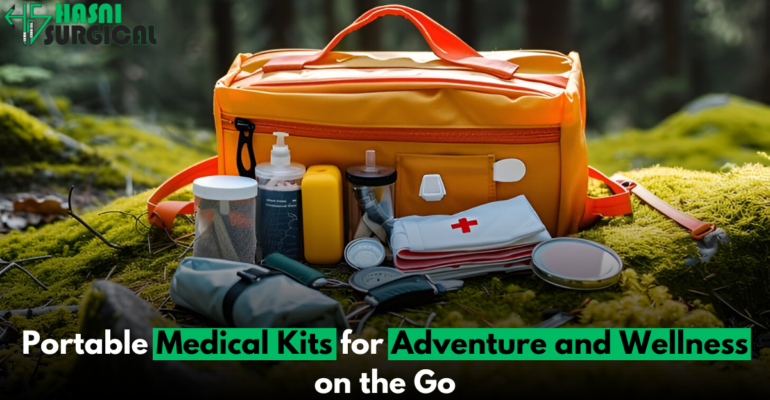5 Essential Portable Medical Kits for Adventure and Wellness on the Go
January 8, 2025 2025-01-08 7:335 Essential Portable Medical Kits for Adventure and Wellness on the Go

5 Essential Portable Medical Kits for Adventure and Wellness on the Go
There is freedom, adventure, and connection to nature about exploring the great outdoors. Whether it is hiking across rugged trails, embarking on a cross-country road trip, or camping under starry skies, there’s one absolutely indispensable item that should not be forgotten: a portable medical kit. Lifesavers come in a compact shape, designed specifically for the rigors of adventure seekers, maintaining wellness and safety on the go.
This is the blog discussing why you must have portable medical kits, what medical equipment to take in them, and some tips on customizing them depending on the adventures you do.
Why Portable Medical Kits Matter
Outdoor activities often take you far from urban conveniences, including medical care. While the serenity of a remote mountain or a secluded beach is refreshing, it also comes with risks:
- Injuries: Scrapes, cuts, or bruises can occur when hiking or engaging in sports.
- Environmental Hazards: Bug bites, sunburn, or allergic reactions can dampen the experience.
- Emergencies: Accidents like sprains or dehydration demand quick responses, especially when professional help is hours away.
A well-equipped portable medical kit allows you to handle these situations effectively. Beyond immediate care, it empowers you to be self-sufficient, turning potential mishaps into manageable inconveniences.
What to Pack in Your Kit
The perfect medical kit is one that balances compactness with functionality. Here’s a breakdown of essentials:

1. Wound Care Basics
- Adhesive Bandages: Pack several sizes for minor cuts and blisters.
- Antiseptic Wipes: Clean wounds to prevent infections.
- Sterile gauge and tape: Use for dressing larger injuries.
- Antibiotic Ointment: Encourages healing and prevents infection.

2. Medications
- Pain Relievers: Such as ibuprofen or acetaminophen for headaches, muscle pain, or fever.
- Antihistamines: For allergies or bug bites.
- Anti-Diarrheal Tablets: Must carry with travelers who venture off into remote areas.
- Rehydration Salts: In case of dehydration due to exercise or illness.

3. Equipment and Miscellaneous
- Tweezers: Remove splinters or ticks
- Scissors: Use for cutting gauze or tape
- Thermometer: Small digital sizes work best
- Safety Pins: Bandage holder or temporary fixes
- Gloves: One-time use gloves keep one’s hands clean while treating themselves.

4. Survival Supplemental
- Emergency Blanket: Useful for preventing hypothermia in cold environments
- Multi-Tool: Knife, pliers, and other tools built-in
- Whistle: Signals for help if stranded.

5. Activity-Specific Gear
- Hikers: Moleskin for blisters and a snakebite kit if hiking in certain areas.
- Campers: Fire-starting tools and water purification tablets.
- Travelers: Motion sickness remedies and travel-size sanitizers.

Customize Your Backpacking Kit
Each adventure will be unique, and your kit should be as well. Let’s customize.
Think about the Environment
A kit to take to the snowy mountain is different from one taken to the tropical rainforest. Cold climates require frost-bite creams and hand warmers, whereas humid weather requires anti-fungal powders and extra hydration supplies.
Length and Number of People
Longer journeys require more supplies. If you travel in a group, adjust to meet the needs of everyone in the group. For individual travelers, smaller packs with versatile items are preferable.
Personal Health Needs
Plan around chronic illness or allergies, and particular medications. If you get blisters easily, include extra for foot care.
Compact Kits for Various Explorations

Hiker’s Essentials Kit
Most hikers prefer light, space-saving items. A hiker’s compact kit would contain:
- Lightweight adhesive bandages.
- A collapsible water bottle with purification tablets.
- A compact survival whistle.
- Moleskin for preventing blisters.

Traveler’s On-the-Go Kit
Travelers who pass borders or climates require the ability to adapt. Look at:
- Medications against motion sickness and stomach disorder.
- Universal power adapters for digital thermometers.
- Multi-language emergency cards for rapid communication.

Camper’s All-in-One Kit
For campers that will be out for a long period of time:
- Fire-starting supplies in case of emergency.
- Additional gauze and strong adhesive tape for injuries.
- Other accessories, such as multi-purpose knife.
Tips to Keep Your Kit Alive
A portable medical kit is only as good as its maintenance. Use these tips to ensure readiness:
- Regular Checks: Look for expired medications or damaged supplies.
- Refill After Use: Replace all items used on an adventure.
- Adapt Over Time: Change contents if new experiences or changes in the destination occur.

Portable Kits in Action
Consider this: You are hiking through dense woods. Suddenly, you feel a loose limb scrape against your leg. With your kit, you clean the wound with an antiseptic wipe, apply antibiotic ointment, and place a bandage. Suddenly, a potential source of infection becomes a minor matter.
Think about a camping adventure where, within hours, the temperature drops significantly and you get susceptible to hypothermia. The warmth of your emergency blanket will keep you warm while awaiting help or improving weather conditions.
Conclusion:
Adventure and wellness go hand in hand if you are prepared. But an emergency kit is more than just a box full of supplies; it has become synonymous with peace of mind and serves almost as a safety net—an indispensable tool in any explorer’s armoury.
Invest in a better kit, make it your own according to your needs, and really take it seriously. Climb mountains or walk through cities, but have your medical kit be silent always, ready at hand to keep you safe and sound.
Pack smart, travel safe, and take on your journey.
